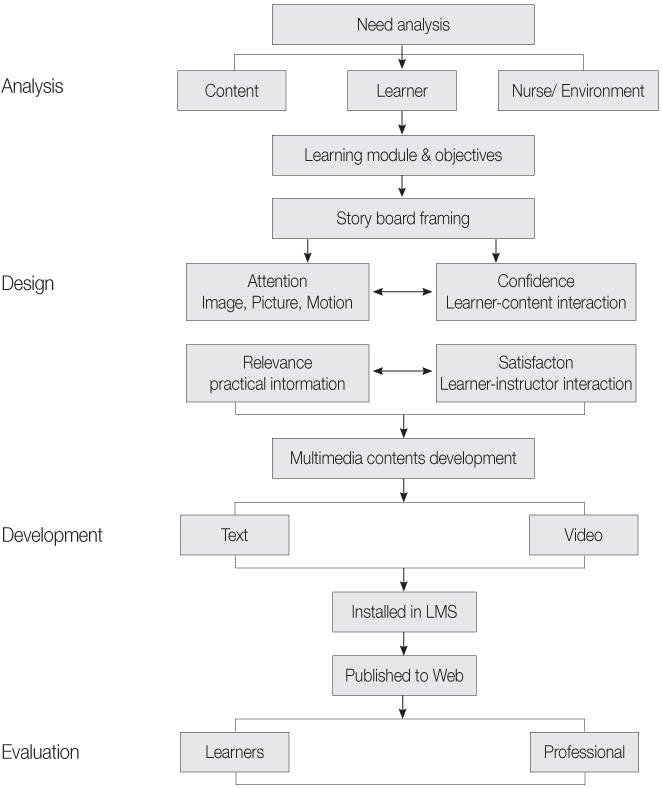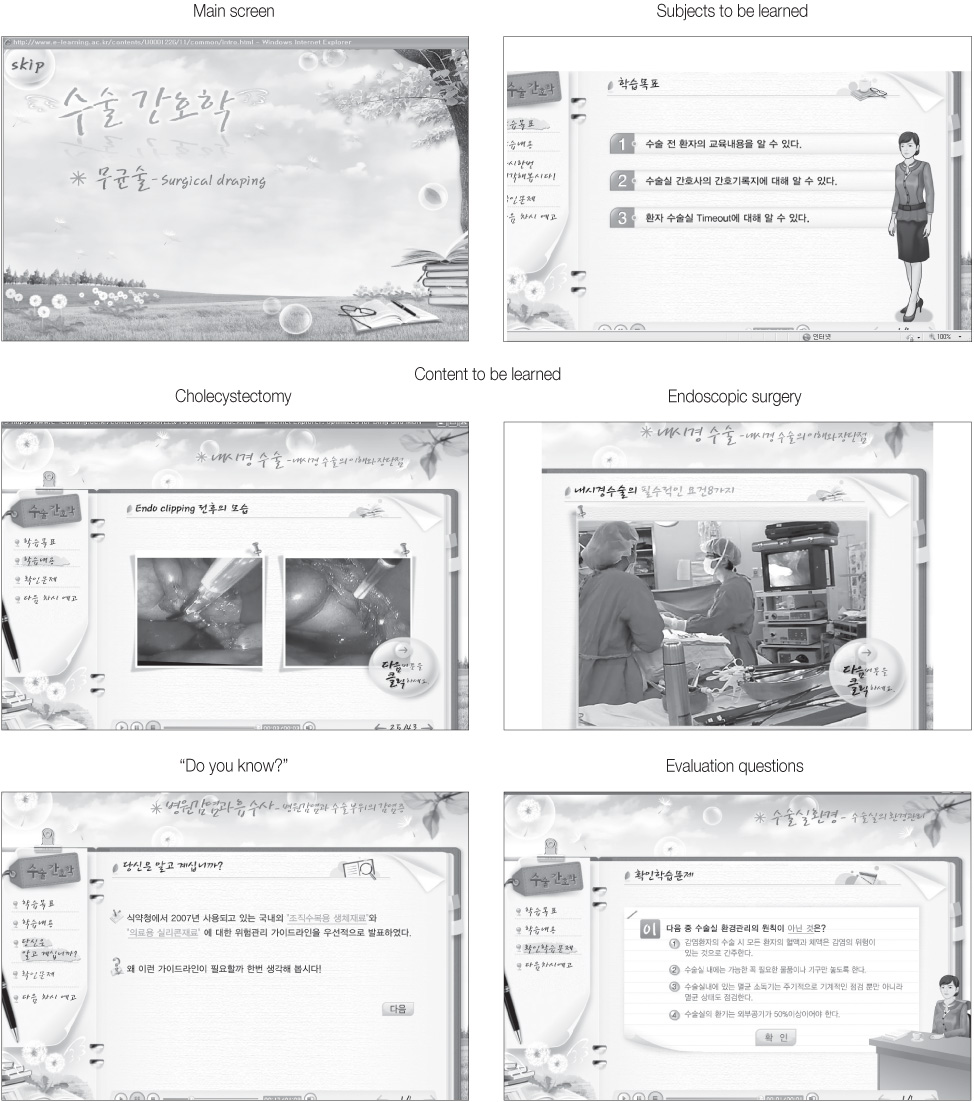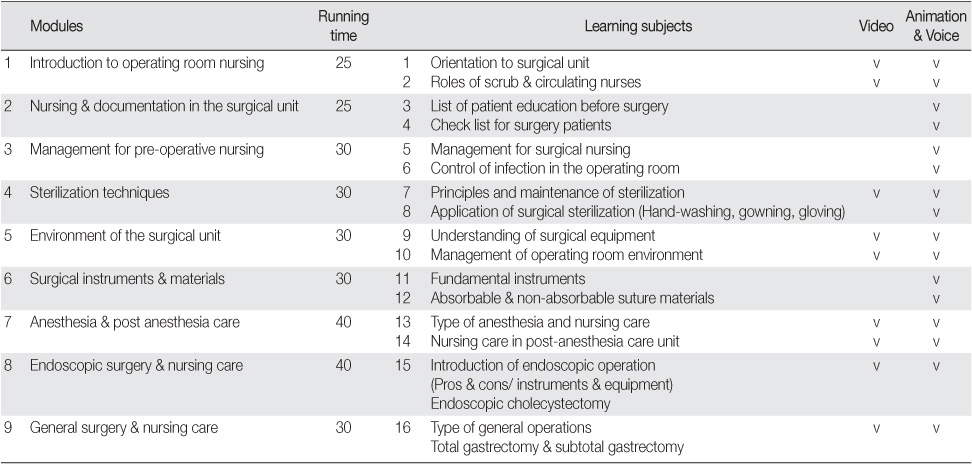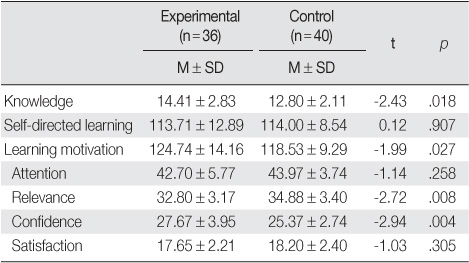Articles
- Page Path
- HOME > J Korean Acad Nurs > Volume 41(1); 2011 > Article
-
Original Article
- Development and Effects of an e-Learning Program in Operating Room Nursing for Nursing Students
- Eun Hee Park, Seon Young Hwang
-
Journal of Korean Academy of Nursing 2011;41(1):36-46.
DOI: https://doi.org/10.4040/jkan.2011.41.1.36
Published online: February 28, 2011
1Part-time Lecturer, Department of Nursing, Chosun University, Gwangju, Korea.
2Assistant Professor, Department of Nursing, Chosun University, Gwangju, Korea.
- Address reprint requests to: Hwang, Seon Young. Department of Nursing, Chosun University, 375 Seoseok-dong, Dong-gu, Gwangju 501-717, Korea. Tel: +82-62-230-7637, Fax: +82-62-230-6329, seon9772@chosun.ac.kr
• Received: July 12, 2010 • Accepted: February 25, 2011
© 2011 Korean Society of Nursing Science
Abstract
-
Purpose
- This study was conducted to develop an e-Learning program that assists nursing students' clinical practice in operating room nursing and to examine the learning effects.
-
Methods
- Based on content and need analysis, 9 learning modules were developed for nursing care in operating rooms and with operating equipment. To verify the effects of the program, a quasi-experimental pretest-posttest control group design was employed. The participants in this study were 74 third-year nursing students (34 in the experimental and 40 in the control group) from a junior college in G-city, Korea, who were engaged in a one week clinical practicum in an operating unit. Frequencies, χ2-test and t-test with the SPSS program 17.0 were used to analyze the data.
-
Results
- Knowledge was significantly higher in the experimental group compared to the control group (p=.018). However, there was no significant difference between the two groups in self-directed learning. The experimental group had significantly higher motivation toward learning, which was examined posttest only (p=.027).
-
Conclusion
- These results indicate that the implementation of an e-Learning program needs to be continued as an effective educational tool, but more research on the best way to implement e-Learning in students' practicum is needed.
- 1. An IS, Lee KH, Jeon SY, Chung SK, Kim KA, Park JS. Development of multimedia education program for newly employed nurses in the operating room. Journal of Korean Society of Medical Informatics. 2000;6(4):73–85.
- 2. Billings DM. A framework for assessing outcomes and practices in web-based courses in nursing. Journal of Nursing Education. 2000;39(2):60–67.ArticlePubMed
- 3. Cho MH, Kwon IS. A study on the clinical practice experiences on nursing activities of nursing students. Journal of Korean Academic Society of Nursing Education. 2007;13:143–154.
- 4. Choi JS, Eun Y. A study on the clinical competence according to clinical ladder of operating room nurses. Journal of Korean Academic Society of Nursing Education. 2006;12:60–69.
- 5. Choi K, Kim JS. Effects of an educational program for the reduction of physical restraint use by caregivers in geriatric hospitals. Journal of Korean Academy of Nursing. 2009;39:769–780.ArticlePubMed
- 6. Gresty K, Skirton H, Evenden A. Addressing the issue of e-learning and online genetics for health professionals. Nursing and Health Sciences. 2007;9(1):14–22.ArticlePubMed
- 7. Guglielmino PJ. Development of self-directed learning readiness scale. 1997;Georgia, Georgia University.
- 8. Jang HJ. The development and effectiveness of coursewear for injection. 1996;Seoul, Ewha Woman's University. Unpublished Doctoral dissertation.
- 9. Jang HY. Analysis of core nursing interventions according to the importance and the performance perceived by operating room nurses. 2007;Seoul, Seoul National University. Unpublished master's thesis.
- 10. Jang KS, Hwang SY, Park SJ, Kim YM, Kim MJ. Effects of a web-based teaching method on undergraduate nursing students' learning of electrocardiography. Journal of Korean Academic Society of Nursing Education. 2005;44:35–39.Article
- 11. Keller JM. . Motivation design of instruction in CM Reigeluth (Ed.). Instructional design theories and models. 1994;Retrieved May 25, 2010. from http://www.arcsmodel.com.
- 12. Kim HY. Developing and verifying validity of a clinical ladder system for operating room nurses. 2010;Gwangju, Chonnam National University. Unpublished doctor's thesis.
- 13. Kim JS. Development and effect of a web-based child health care program for the staff at child daycare centers. Journal of Korean Academy of Nursing. 2010;40:213–224.ArticlePubMed
- 14. Kim JS, Kim MS, Hwang SK. Development of an e-learning education program for preventing nursing errors and adverse events of operating room nurses. Journal of Korean Academy of Adult Nursing. 2005;17:697–707.
- 15. Kim SY, Choi SS, Kim YH, Kwag WH, Kim MS, Hyun MS. The development and application of e-learning orientation program for new nurses. Clinical Nursing Research. 2004;10(1):97–109.
- 16. Kim SY, Ju SJ. The study of e-learning status in nursing student. Journal of Korean Academic Society of Nursing Education. 2006;12:86–94.
- 17. Kim YH. Effects of utilizing animation prior to fundamental nursing practice on learning motivation and self-directedness in student nurses. Journal of Korean Academy of Fundamentals Nursing. 2010;17:240–248.
- 18. Park JH, Lee EH, Bae SH. Factors influencing learning achievement of nursing students in e-learning. Journal of Korean Academy of Nursing. 2010;40:182–190.ArticlePubMed
- 19. Park KS, Hwang YY, Choi EH. The study of the nursing students' lived experience of clinical practice at the intensive care unit. Journal of Korean Academy of Adult Nursing. 2003;15:373–381.
- 20. Lee MJ. Effectiveness of hands-on education for nursing conducting clinical practice in operation rooms. 2007;Seongmam, Eulji University. Unpublished Master's thesis.
- 21. Matsuda Y, Takeuchi T, Takahashi Y, Ozawa K, Nishimoto Y, Terauti H. Development and evaluation of the e-learning teaching materials for surgical nursing training. Studies in Health Technology and Informatics. 2006;122:811. PubMed
- 22. Moon YS. Consideration of education efficacy and practice satisfaction on operating room clinical practice. 1999;Seoul, Korea University. Unpublished master's thesis.
- 23. Sharif F, Masoumi S. A qualitative study of nursing student experiences of clinical practice. BMC Nursing. 2005;4:6. PubMedPMC
- 24. So HS, Bae YS, Kim YO, Kim SM, Kang HY, Choi JY, et al. Development of web-based multimedia contents for the critical care practice of nursing students through inter-college collaboration. Journal of Korean Academy of Adult Nursing. 2008;20:778–790.
- 25. Sung YH, Kwon IG, Hwang JW, Kim JY. Development of an e-learning program about medication for new nurses. Journal of Korean Academy of Nursing. 2005;35:1113–1124.ArticlePubMedPDF
- 26. Tse MM, Pun SP, Chan MF. Pedagogy for teaching and learning cooperatively on the web: A web-based pharmacology course. Cyberpsychology Behavior. 2007;10(1):32–37.ArticlePubMed
- 27. Willemsen-McBride T. Preceptorship planning is essential to perioperative nursing retention: Matching teaching and learning styles. Canadian Operating Room Nursing Journal. 2010;28(1):8–16.PubMed
- 28. Yi YJ. Development and evaluation of the e-learning orientation program for nursing student's adapting to clinical practicum. Journal of Korean Academy of Adult Nursing. 2007;19:593–602.
- 29. Yoo KY. Demographic and socio-psychological variables to adults' self-direction in learning. Korean Journal of Adult & Continuing Education. 1998;4(1):119–149.
- 30. Yoo MS. The effectiveness of standardized patient managed instruction for a fundamental nursing course. Journal of Korean Academic Society of Nursing Education. 2001;7:94–112.
REFERENCES
Figure & Data
REFERENCES
Citations
Citations to this article as recorded by 

- Evaluating self-directed learning competencies in digital learning environments: A meta-analysis
De-Chih Lee, Ching-Yi Chang
Education and Information Technologies.2025; 30(6): 6847. CrossRef - Development and Evaluation of Nursing Clinical Practice Education Using M-Learning
Sungeun Kim, Mihae Im
Healthcare.2024; 12(2): 206. CrossRef - A competency-based guided-learning algorithm applied on adaptively guiding e-learning
Wei-Chih Hsu, Cheng-Hsiu Li
Interactive Learning Environments.2015; 23(1): 106. CrossRef - An Adaptively-Guiding Web-Based E-Learning System Based on Competency-Based Learning Theory
Wei Chih Hsu, Cheng Hsiu Li
Applied Mechanics and Materials.2013; 284-287: 3305. CrossRef - Effects of a Web-based Learning Contents in Operating Room Nursing for Nursing Students
Eun-Hee Park, Seon-Young Hwang
The Journal of the Korea Contents Association.2011; 11(9): 384. CrossRef
Development and Effects of an e-Learning Program in Operating Room Nursing for Nursing Students



Figure 1
Research design of this study.
Figure 2
Steps in developing an e-Learning program for operating room nursing according to ARCS Model.
Figure 3
Samples of screen shots included in the e-Learning program.
Figure 1
Figure 2
Figure 3
Development and Effects of an e-Learning Program in Operating Room Nursing for Nursing Students
Composition of Learning Modules and Subjects
Differences in Post-test Scores between Experimental and Control Groups
Table 1
Composition of Learning Modules and Subjects
Table 2
Differences in Post-test Scores between Experimental and Control Groups
 KSNS
KSNS
 E-SUBMISSION
E-SUBMISSION





 Cite
Cite

